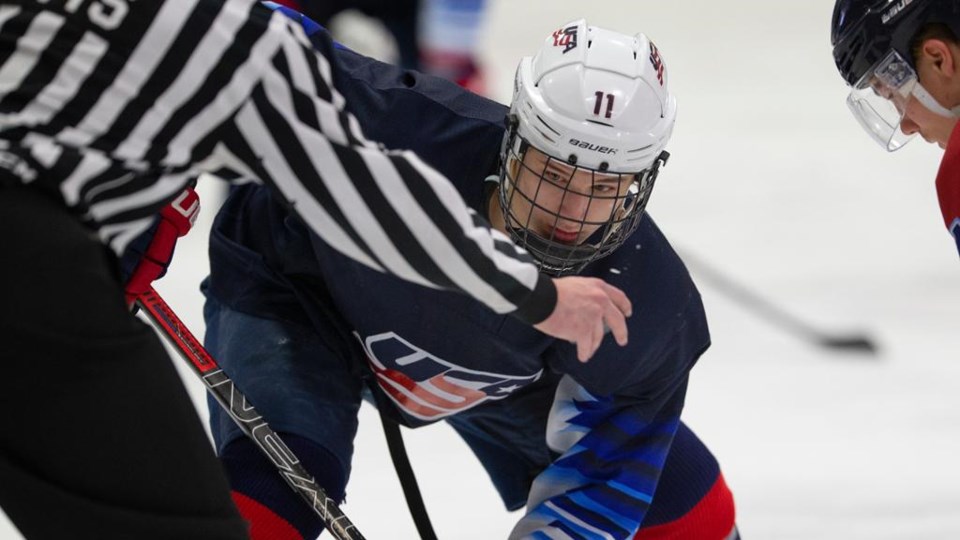One thing clearly lacking in the Canucks roster is playmaking talent. Elias Pettersson is fantastic, Brock Boeser is a decent passer, and Bo Horvat has improved significantly in that area, but after that playmakers get a bit more sparse.
Sven Baertschi, when healthy, can make plays and Nikolay Goldobin, when he’s in the lineup and engaged, is a creative player, but who else on the Canucks really strikes you with his creative playmaking ability?
The Canucks need more creativity in their lineup, as they’re currently bogged down with third-liners that are capable in the defensive zone, but don’t create much offensively. While they could seek out solutions in free agency or on the trade market, the best place to find creative top-six forwards is at the top of the draft.
The Canucks will have options at tenth overall, assuming they don’t trade the pick, with a number of compelling forwards expected to be available. That could include top talents like Cole Caufield, Matthew Boldy, Peyton Krebs, and Alex Newhook, all of whom have first-line potential and would be a great fit alongside the Canucks’ young core.
The most creative playmaker that could be available, however, is Trevor Zegras.
Zegras was part of the monstrous US National Team Development Program alongside Caufield, Boldy, Alex Turcotte, and Jack Hughes. He racked up 87 points in 60 games, including 40 points in 27 USHL games. Only Hughes and Caufield had more points for the USNTDP this season.
Although he missed the first couple of games of the U-18 World Championships, he was one of the top scorers as soon as he got back into the lineup. He tallied nine points, all assists, in five games. Once again, only Hughes and Caufield had more points per game than Zegras.
Zegras is a remarkable playmaker, with exceptional vision and a knack for putting pucks right on a teammate’s stick in wildly unexpected ways. He’s particularly fond of spinning backhand passes and I don’t say it lightly when I suggest his backhand saucer passes are reminiscent of the Sedins.
That passing ability sets Zegras apart from the rest of his draft class, as he makes plays that other prospects wouldn’t even consider, much less attempt. He can make plays in so many different ways as well, whether it’s chipping a puck over a defender for a teammate to skate onto, saucering a pass over a stick, banking the puck off the boards, or dropping the puck between his legs. His bag of tricks is seemingly bottomless.
“He’s a special playmaker and one of the best passers I’ve seen as a first-year draft-eligible in recent years,” says Corey Pronman of the Athletic.
Zegras matches that playmaking with fantastic hands that allow him to beat a defender one-on-one or control the puck until a passing lane opens up. His creativity shows up in his handles as well, as he’ll bank the puck off the back of the net to himself, poke it through a defender’s legs to avoid a check, or use quick changes of speed and direction to bamboozle a defender. He’s a delight to watch.
While he’s certainly a pass-first player, Zegras also has a plus shot with a quick release, which makes him even more dangerous offensively, as goaltenders can’t just expect a pass. His skating allows him to dart into open areas for scoring chances or get separation off the rush, giving him more opportunities to put the puck in the net.
“[Zegras] often enters a shooting stance before passing, keeping his toes and eyes locked towards the goal as he rips a pass across the slot,” says Mitch Brown of Elite Prospects. “This little detail opens a better look for his teammate, as the shooting stance freezes the goaltender and defenders.”
On top of all that, Zegras is a responsible two-way forward, active on the backcheck with nifty stick lifts and steals, and showing a bit of physicality and agitation to his game. He’s versatile to boot, capable of playing on both the wing and at centre, as he did when Jack Hughes was injured.
He’s not without flaws, however, with some scouts questioning his decision-making. Zegras is so confident in his hands and passing that he sometimes forces plays instead of taking the more simple play that was available to him.
One NHL scout quoted in Hockey Prospect’s Black Book raged about Zegras: “F***ing kid had a 2-on-1 and all he had to do was make the simple pass, but no, he had to pull some fluff bull**** fancy dangle garbage and the Russian D took it away from him.”
That’s one of the biggest concerns for Zegras: some of the low-percentage plays he makes will get him in trouble at the NHL level, resulting in turnovers and dangerous chances in transition for his opponents. If Zegras can iron out that element of his game as he matures, he could be an incredibly dangerous top-six forward, particularly as a playmaker on the power play.
Zegras would certainly make sense for the Canucks: he would be a wonderful complement to Elias Pettersson and Brock Boeser, as well as an insurance policy at centre if Pettersson or Bo Horvat got injured.
Will he still be available? Zegras is frequently ranked in the top ten in the draft, with some edging him into the top five. The Canucks certainly aren’t the only team in need of a creative playmaker.
If Zegras gets picked ahead of tenth overall, however, that means the likes of Peyton Krebs or Matthew Boldy will likely slide to tenth, if not a top-ranked player like Vasili Podkolzin, Dylan Cozens, or Kirby Dach. With the wealth of forward talent available, it’s going to be hard for the Canucks to go wrong.



